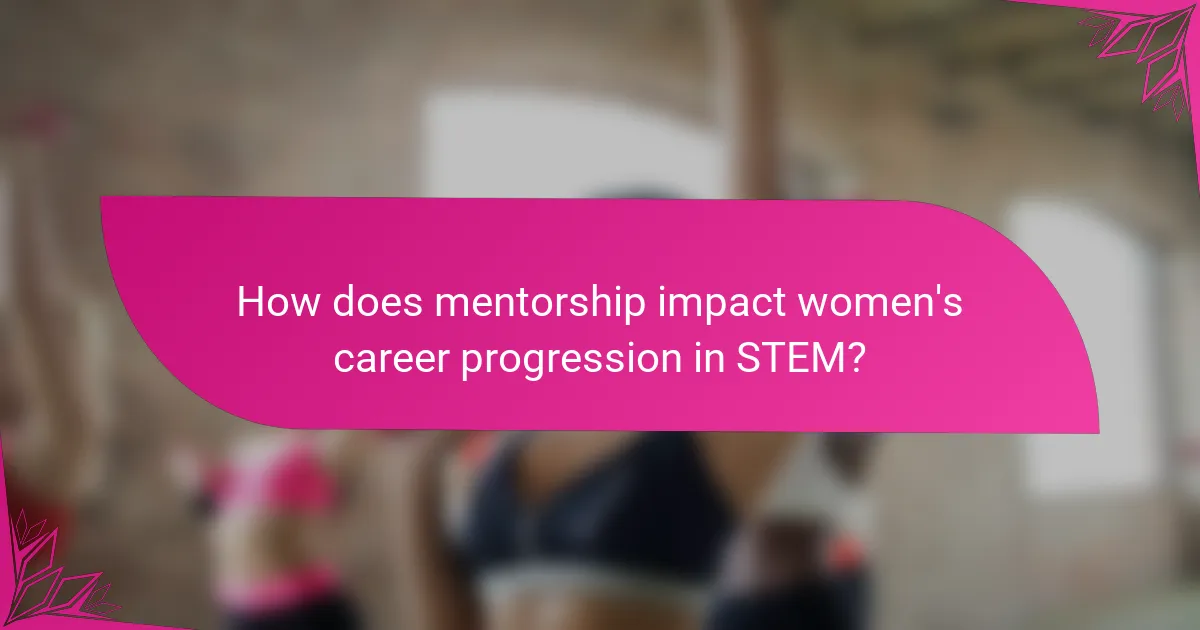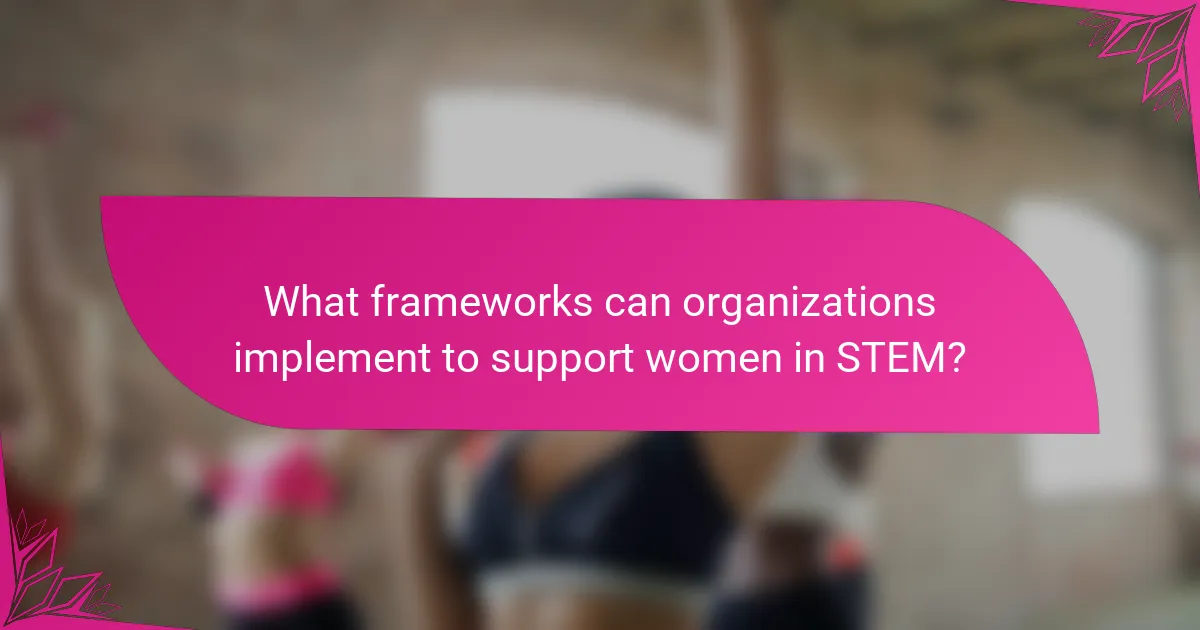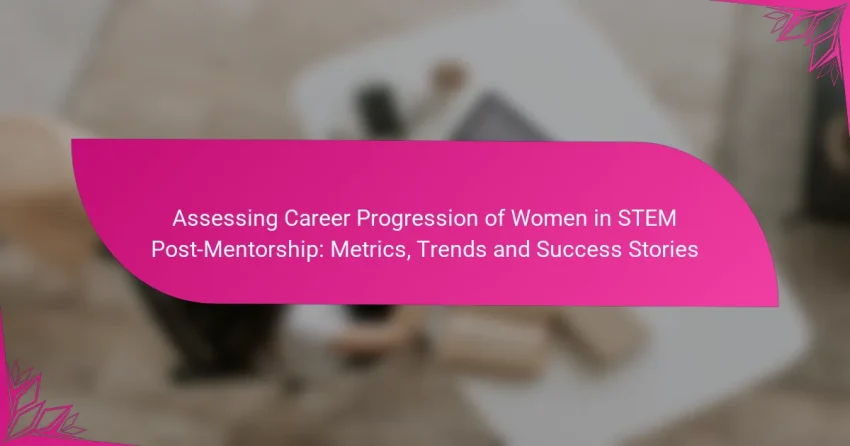Assessing the career progression of women in STEM after mentorship reveals critical insights into their advancement and success. By examining key metrics such as salary growth, leadership positions, and retention rates, we can better understand the impact of mentorship programs. This analysis highlights the significant strides women are making in technical fields and the evolving workplace culture that supports their growth.

How does mentorship impact women’s career progression in STEM?
Mentorship significantly enhances women’s career progression in STEM by providing guidance, support, and opportunities for advancement. Effective mentorship can lead to measurable improvements in promotion rates, job satisfaction, and the expansion of professional networks.
Increased promotion rates
Women who engage in mentorship programs often experience higher promotion rates compared to those who do not. Mentors can advocate for their mentees, helping them navigate organizational politics and identify opportunities for advancement. Studies suggest that mentored women may see promotion rates increase by a notable margin, often in the range of 20-30% compared to their unmentored peers.
To maximize the benefits of mentorship, women should actively seek mentors who are well-connected and knowledgeable about their industry. Setting clear career goals and discussing them with mentors can also help align efforts towards achieving promotions.
Higher job satisfaction
Mentorship contributes to higher job satisfaction among women in STEM fields. Having a mentor provides emotional support and guidance, which can lead to a more positive work experience. Research indicates that mentored women report significantly greater job satisfaction levels, often attributed to increased confidence and a clearer career path.
To enhance job satisfaction through mentorship, women should choose mentors who share similar values and career aspirations. Regular check-ins with mentors can help address challenges and reinforce a sense of belonging within the workplace.
Expanded professional networks
Mentorship helps women in STEM expand their professional networks, which is crucial for career advancement. Mentors often introduce their mentees to influential contacts, opening doors to new opportunities and collaborations. This expanded network can lead to increased visibility and access to resources within the industry.
Women should actively leverage their mentors’ networks by seeking introductions and participating in industry events. Building relationships with peers and other professionals can further enhance these connections, creating a robust support system for career growth.

What metrics are used to assess career progression post-mentorship?
To evaluate career progression of women in STEM after mentorship, key metrics include salary growth, leadership positions attained, and retention rates within the field. These indicators provide insights into the effectiveness of mentorship programs and the overall advancement of women in technical careers.
Salary growth
Salary growth is a crucial metric for assessing career progression post-mentorship. It reflects not only the financial benefits of mentorship but also the value placed on women’s contributions in STEM fields. Typically, women who have undergone mentorship may experience salary increases ranging from 10% to 30% within a few years.
To effectively measure salary growth, compare pre-mentorship salaries with post-mentorship earnings. Consider factors such as industry standards and regional salary averages, which can vary significantly across different countries and sectors.
Leadership positions
Tracking the number of women in leadership positions is another vital metric for assessing career progression after mentorship. Success in securing roles such as team leads, project managers, or executives indicates the effectiveness of mentorship in empowering women to take on greater responsibilities.
Organizations should aim for a balanced representation of women in leadership roles, ideally targeting a minimum of 30% in management positions. This can be benchmarked against industry averages to gauge progress and identify areas for improvement.
Retention rates
Retention rates measure how many women remain in STEM careers after mentorship, indicating job satisfaction and career stability. High retention rates suggest that mentorship programs are successful in fostering a supportive work environment that encourages women to stay in their roles.
To analyze retention, organizations can track the percentage of women who remain employed in STEM fields over a set period, typically 1 to 5 years post-mentorship. A retention rate above 80% is generally considered strong, reflecting effective mentorship and workplace culture.

What trends are observed in women’s career advancement in STEM?
Women’s career advancement in STEM is increasingly marked by significant progress in leadership roles, participation rates, and workplace culture. These trends reflect a growing recognition of the value women bring to the field and the importance of equitable representation.
Rising representation in leadership
Women are increasingly occupying leadership positions within STEM organizations, with many companies actively promoting gender diversity in their executive ranks. This shift is often driven by mentorship programs and initiatives aimed at developing female talent, resulting in a more balanced leadership landscape.
Organizations that prioritize female leadership often see improved team performance and innovation. For instance, companies with women in executive roles report higher profitability and productivity, highlighting the benefits of diverse perspectives in decision-making.
Increased participation in STEM fields
The number of women entering STEM fields has steadily increased over recent years, with many universities reporting higher enrollment rates for female students in science and engineering programs. This growth is supported by outreach programs that encourage young girls to pursue STEM education and careers.
As participation rises, women are not only entering the workforce but also advancing into technical and specialized roles. This trend is crucial for closing the gender gap, as it leads to a more inclusive environment where diverse talents can thrive.
Shifts in workplace culture
Workplace culture in STEM industries is evolving to become more inclusive and supportive of women. Companies are implementing policies that promote work-life balance, flexible hours, and parental leave, which are essential for retaining female talent.
Additionally, organizations are fostering environments that encourage collaboration and mentorship among employees. These cultural shifts help to dismantle barriers that previously hindered women’s career progression, creating a more equitable landscape for all professionals in STEM.

What success stories highlight the impact of mentorship?
Mentorship has significantly influenced the careers of women in STEM, leading to notable success stories that demonstrate its effectiveness. These stories illustrate how guidance and support can propel women into leadership roles and innovative positions in their fields.
Dr. Fei-Fei Li at Stanford University
Dr. Fei-Fei Li, a prominent figure in artificial intelligence, credits her mentorship experiences for her success. As the co-director of Stanford’s Human-Centered AI Institute, she emphasizes the importance of mentorship in fostering diversity and innovation in technology. Her work has inspired many young women to pursue careers in AI and machine learning.
Li’s initiatives, such as the AI4ALL program, aim to educate and empower underrepresented groups in AI, showcasing how mentorship can create pathways for future leaders in STEM.
Dr. Lisa Su at AMD
Dr. Lisa Su, the CEO of AMD, exemplifies the impact of mentorship in the semiconductor industry. Under the guidance of experienced leaders, she developed her technical and managerial skills, which helped her rise through the ranks. Su’s leadership has transformed AMD into a competitive force in the technology market.
Her commitment to mentoring the next generation of engineers is evident through AMD’s initiatives that support women and minorities in STEM, reinforcing the importance of mentorship in achieving career advancement.
Dr. Ellen Ochoa at NASA
Dr. Ellen Ochoa, the first Hispanic woman in space, has had a profound impact on the aerospace industry through her mentorship. As a former director of NASA’s Johnson Space Center, she has dedicated her career to inspiring young women to pursue careers in science and engineering. Ochoa’s journey highlights how mentorship can break barriers and encourage diversity in STEM fields.
Through her outreach programs and public speaking engagements, Ochoa continues to advocate for mentorship, emphasizing its role in shaping the future of aerospace and technology.

What frameworks can organizations implement to support women in STEM?
Organizations can implement various frameworks to effectively support women in STEM, focusing on mentorship programs and diversity training initiatives. These frameworks aim to create an inclusive environment that fosters career growth and addresses systemic barriers.
Mentorship programs
Mentorship programs are essential for guiding women in STEM through their career paths. These programs typically pair experienced professionals with mentees to provide advice, share experiences, and help navigate workplace challenges.
To establish a successful mentorship program, organizations should consider structured matching processes, regular check-ins, and clear goals for both mentors and mentees. For instance, a program might include monthly meetings and specific objectives related to skill development or networking opportunities.
Common pitfalls include inadequate training for mentors and lack of commitment from participants. Organizations should ensure mentors are equipped with the necessary skills and that both parties are motivated to engage fully in the process.
Diversity training initiatives
Diversity training initiatives are vital for fostering an inclusive workplace culture that supports women in STEM. These programs educate employees about unconscious biases, promote understanding of diverse perspectives, and encourage inclusive behaviors.
Effective diversity training should be ongoing and incorporate real-world scenarios relevant to the organization. For example, workshops can include role-playing exercises that help participants recognize and address biases in hiring or team dynamics.
Organizations should avoid one-off training sessions, as they often fail to create lasting change. Instead, implementing regular training sessions and integrating diversity goals into performance evaluations can lead to more significant improvements in workplace culture.

How do geographical factors influence women’s career progression in STEM?
Geographical factors significantly impact women’s career progression in STEM fields by shaping access to education, mentorship opportunities, and workplace environments. Regions with supportive policies and infrastructure tend to foster better advancement for women in these careers.
Access to Education and Training
Access to quality education and training programs varies widely across different regions, affecting women’s entry into STEM fields. Urban areas often provide more resources, such as universities and vocational training centers, compared to rural locations. Women in regions with limited educational options may face challenges in acquiring necessary skills.
For instance, countries in Northern Europe generally have strong educational frameworks that promote STEM for women, while some developing regions may struggle with basic educational access. This disparity can lead to significant differences in career opportunities.
Mentorship and Networking Opportunities
Geographical location influences the availability of mentorship and networking opportunities, which are crucial for career advancement in STEM. Areas with active professional networks and organizations dedicated to women in STEM can provide essential support and guidance.
In cities with vibrant tech hubs, women often find more mentors and peers to connect with, enhancing their career prospects. Conversely, in regions lacking such networks, women may feel isolated and unsupported in their professional journeys.
Workplace Environment and Policies
The workplace environment, including company policies on diversity and inclusion, varies by geography and significantly affects women’s career progression in STEM. Regions with progressive labor laws and corporate practices tend to create more equitable workplaces.
For example, countries with strong parental leave policies and flexible work arrangements often see higher retention rates of women in STEM roles. In contrast, areas with rigid workplace cultures may hinder women’s advancement and job satisfaction.
Regional Economic Factors
Economic conditions in a region can also dictate the availability of STEM jobs and the overall career trajectory for women. Regions with booming tech industries typically offer more opportunities, while economically depressed areas may see fewer job openings.
Women in economically thriving regions may have access to higher salaries and better benefits, which can encourage them to pursue and remain in STEM careers. In contrast, women in struggling economies may face salary disparities and limited job security.
